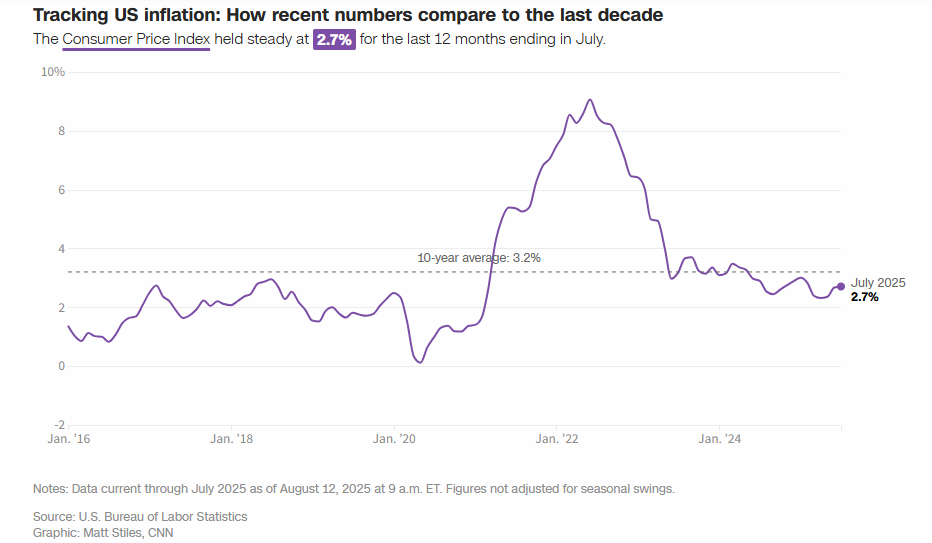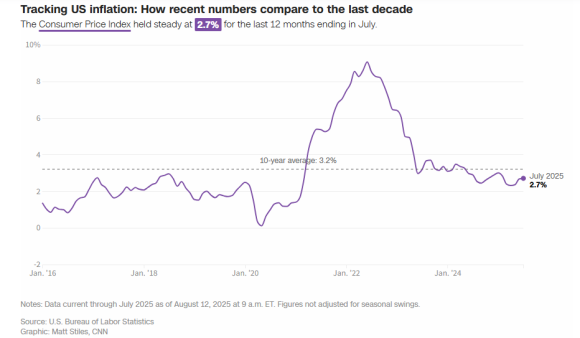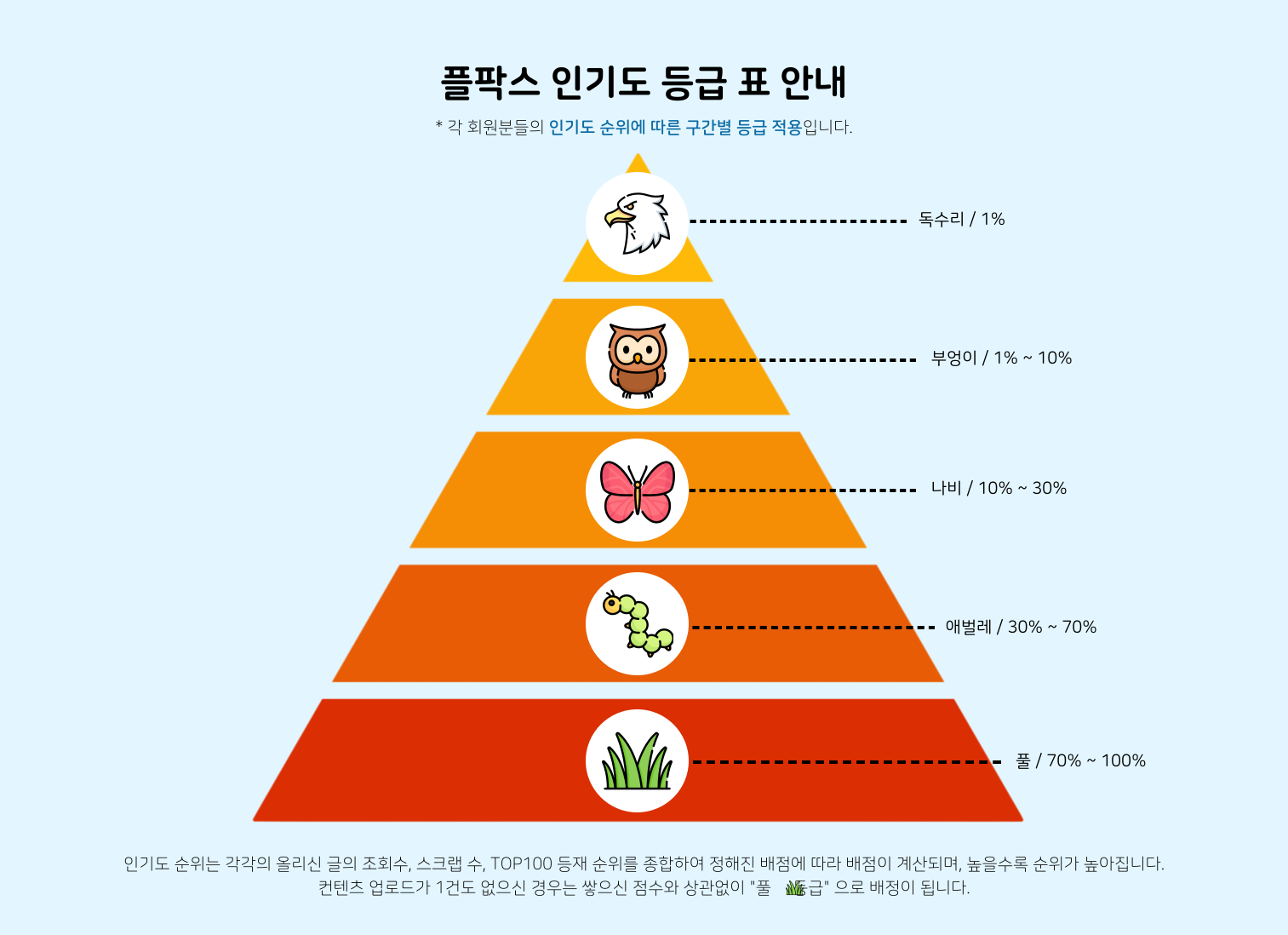
Falling gas prices helped keep overall inflation tame in July; however, a broader array of products got even more expensive last month, showing that President Donald Trump’s expansive tariffs are being passed along to consumers.
7월 휘발유 가격 하락은 전체적인 물가 상승률을 억제하는 데 도움이 됐습니다. 그러나 지난달에는 더 다양한 상품 가격이 오르면서 도널드 트럼프 대통령의 광범위한 관세 정책이 소비자에게 전가되고 있음을 보여주었습니다.
Consumer prices rose 0.2% in July, keeping the annual inflation rate at 2.7%, according to the latest Consumer Price Index data released Tuesday by the Bureau of Labor Statistics.
미국 노동통계국(Bureau of Labor Statistics)이 화요일 발표한 최신 소비자물가지수(CPI) 자료에 따르면, 7월 소비자물가는 0.2% 상승해 연간 인플레이션율을 2.7%로 유지했습니다.
Stocks were higher on Tuesday. The Dow rose 480 points, or 1.09%. The S&P 500 rose 0.73% and the Nasdaq Composite gained 0.72%.
주식시장은 화요일 상승세를 보였습니다. 다우지수는 480포인트(1.09%) 올랐고, S&P 500지수는 0.73%, 나스닥 종합지수는 0.72% 상승했습니다.
“We have seen moderate inflation over the last year … certainly, prices are not going up nearly as quickly as they were a few years ago,” Gus Faucher, senior vice president and chief economist at PNC Financial Services Group, told CNN in an interview. “But I do think that consumers are going to start seeing more price increases at the grocery store, at Amazon, things like that.”
PNC 파이낸셜 서비스 그룹의 수석 부사장이자 수석 이코노미스트인 거스 포처(Gus Faucher)는 CNN과의 인터뷰에서 “지난 1년 동안 우리는 완만한 인플레이션을 보았습니다. 물론 몇 년 전처럼 가격이 빠르게 오르지는 않고 있습니다”라며 “하지만 소비자들은 앞으로 식료품점, 아마존 등에서 더 많은 가격 인상을 보게 될 것이라 생각합니다”라고 말했습니다.
“Consumers are going to start to feel a little more stretched over the next few months as we see more of the impact of tariffs passed through from businesses to consumers,” he added.
그는 이어 “향후 몇 달간 기업에서 소비자로 관세 부담이 전가되면서 소비자들은 점점 더 경제적으로 압박을 느끼게 될 것”이라고 덧붙였습니다.
However, considering that energy and food prices tend to be quite volatile on a month-to-month basis, the “core” index that excludes those two categories is widely viewed as a good measurement of underlying inflation trends.
다만 에너지와 식품 가격은 월별 변동성이 큰 편이어서, 이 두 부문을 제외한 ‘근원(Core)’ 지수가 기초적인 인플레이션 추세를 가늠하는 지표로 널리 사용됩니다.
Core CPI rose 0.3% from June, the fastest increase since January, which brought the annual rate to 3.1%, the highest in five months.
근원 CPI는 6월 대비 0.3% 올라 지난 1월 이후 가장 큰 상승폭을 기록했으며, 연간 상승률은 3.1%로 5개월 만에 최고치를 나타냈습니다.
“Gas prices are down, but we can’t count on that to keep inflation low,” Faucher said. “So, even if energy prices stabilize and gas prices are just stable, then that means that overall inflation is going to be higher, and that is going to put more pressure on consumers.”
포처는 “휘발유 가격이 내렸지만, 이것이 인플레이션을 계속 낮게 유지해 줄 것이라고 기대할 수 없습니다”라며 “에너지 가격이 안정되고 휘발유 가격이 그냥 유지되더라도, 전체적인 인플레이션은 더 높아지고 이는 소비자에게 더 큰 압박을 줄 것”이라고 말했습니다.
The core goods category, which is being closely scrutinized in the wake of higher tariffs, rose 0.2% for the second consecutive month.
관세 인상 이후 주목받고 있는 ‘근원 재화(Core goods)’ 부문은 2개월 연속 0.2% 상승했습니다.
Economists had expected inflation to heat up slightly last month, to 0.2% from June and by 2.8% annually, according to FactSet.
팩트셋(FactSet)에 따르면, 경제학자들은 지난달 인플레이션이 6월 대비 0.2%, 연간 기준으로는 2.8%로 소폭 상승할 것으로 예상했습니다.
While tariff-exposed goods categories did see some price increases in July, the lion’s share of cost pressures came from services, particularly the housing-related shelter category, which has been an inflationary bogeyman in recent years.
관세 영향을 받는 일부 상품군 가격은 7월에 오르긴 했으나, 전체 비용 압박의 대부분은 서비스 부문에서 나왔으며, 특히 최근 몇 년간 인플레이션의 골칫거리였던 주거 관련 ‘쉼터(shelter)’ 부문이 주요 원인이었습니다.
Still, overall shelter prices (which include measurements of rents and other housing-related costs) continued to cool from pandemic-era spikes. Prices rose 0.2% in July and eased to 3.7% from a year ago, the lowest 12-month increase since October 2021.
그럼에도 전체 주거비(임대료 및 기타 주거 관련 비용 포함)는 팬데믹 시기의 급등세에서 계속 완화되는 모습을 보였습니다. 7월 주거비는 0.2% 상승했으며, 연간 상승률은 3.7%로 떨어져 2021년 10월 이후 가장 낮은 12개월 상승률을 기록했습니다.
Trump’s sweeping trade policy of tacking steep tariffs on most goods that cross America’s borders are widely expected to result in higher prices for businesses and consumers — although not to the extent seen in 2022 and other high-inflationary periods.
도널드 트럼프 전 대통령의 전방위적인 무역 정책, 즉 미국 국경을 넘는 대부분의 상품에 높은 관세를 부과하는 조치는, 2022년이나 다른 고(高)인플레이션 시기만큼은 아니더라도 기업과 소비자 모두에게 더 높은 가격 부담을 안길 것으로 널리 예상되고 있습니다.
While there may not be a broad-based acceleration in inflation, higher prices anywhere — especially come Back-to-School season and around the holidays — aren’t easy to swallow for many Americans, especially those with little-to-no wiggle room in their budgets.
인플레이션이 전반적으로 급격히 가속화되지는 않더라도, 특히 개학철(Back-to-School 시즌)과 연말 쇼핑 시즌에 나타나는 가격 인상은 예산에 여유가 거의 없는 많은 미국인들에게 결코 쉽게 받아들이기 어려운 일입니다.
“The thing to understand is [tariff-induced inflation] is not going to happen with a bang but rather more of a slow deterioration in purchasing power,” Joe Brusuelas, RSM US chief economist, told CNN.
RSM US의 수석 이코노미스트 조 브루수엘라스(Joe Brusuelas)는 CNN에 “이해해야 할 점은 [관세로 인한 인플레이션]이 한 번에 ‘쾅’ 하고 나타나는 것이 아니라, 구매력의 점진적인 약화 형태로 나타난다는 것입니다”라고 말했습니다.
Many economists also believe that tariffs will cause a one-time lift in prices and not necessary a lasting and accelerating surge in price hikes.
많은 경제학자들도 관세가 가격을 한 번 끌어올리는 효과를 낼 수는 있지만, 지속적이고 가속적인 가격 폭등으로 이어지지는 않을 것으로 보고 있습니다.
There’s a laundry list of reasons why tariff-driven price hikes are a slow boil: Businesses loaded up their warehouses with pre-tariffed goods; higher costs have been split by entities along the supply chain, lessening the blow at the retail store; and Trump’s fits-and-starts approach to tariffs has meant that the bulk of them did not go into effect for months.
관세로 인한 가격 상승이 ‘서서히 끓는 물’처럼 진행되는 이유는 다양합니다.
기업들이 관세가 적용되기 전 상품을 창고에 미리 대량 비축해 두었고,
공급망의 여러 주체들이 비용 증가를 나누어 부담함으로써 소매점에서의 충격이 완화되었으며,
트럼프 전 대통령이 관세를 시행하는 방식이 간헐적이고 불규칙적이어서, 실제 대부분의 관세가 발효되기까지 몇 달이 걸렸기 때문입니다.
At the same time, inflation has remained relatively tame for good and not-so-good reasons: Ongoing deflationary trends in key areas, marking a continued unwinding from pandemic-era shortages and price spikes; falling gas prices (they’re down 9.5% from July of last year); there are many other components of CPI (core goods are just 25%); and then because of depressed consumer demand in areas such as travel.
한편, 인플레이션이 비교적 억제된 상태를 유지한 이유는 긍정적인 요인과 부정적인 요인이 모두 작용한 결과입니다.
일부 핵심 분야에서는 팬데믹 시기의 공급 부족과 가격 급등에서 벗어나면서 지속적인 디플레이션(가격 하락) 흐름이 이어지고 있고,
휘발유 가격이 하락했으며(전년 7월 대비 9.5% 하락),
CPI(소비자물가지수)에는 다양한 항목이 포함되어 있어 ‘근원 재화’가 차지하는 비중은 25%에 불과하며,
여행과 같은 분야에서는 소비자 수요가 위축되어 있기 때문입니다.
Monthly economic data can be quite volatile, and economists frequently caution that it’s important to take a longer view. However, CPI reports and, especially, July’s data are bearing hallmarks of higher tariffs, albeit in a scattershot fashion:
월별 경제 지표는 변동성이 클 수 있어, 경제학자들은 종종 더 긴 안목에서 바라볼 필요가 있다고 경고합니다. 그러나 소비자물가지수(CPI) 보고서, 특히 7월 데이터는 산발적인 형태이긴 하지만 높은 관세의 흔적을 보여주고 있습니다.
Commodities excluding food and gas: Prices rose 0.2% for the second consecutive month after being flat in May. This index excludes volatile food and energy components and is being closely scrutinized in the wake of higher tariffs.
식품·휘발유 제외 상품: 5월에는 변동이 없었으나, 6월과 7월 연속으로 0.2% 상승했습니다. 이 지수는 변동성이 큰 식품과 에너지를 제외하며, 높은 관세 이후 면밀히 관찰되고 있습니다.
Apparel and footwear: Trump’s tariffs were expected to raise the cost of most clothing and footwear, but the hardest-hit items were expected to be some of the most basic (cheap T-shirts, socks, sneakers and undies). The clothes and shoes that land on retail shelves are largely sourced from countries such as Vietnam and China, which have tariff rates north of 20% and 30%, respectively.
Overall apparel prices nudged up just 0.1% in July after rising 0.4% in June. Footwear, however, shot up 1.4% in July — the highest monthly rate in more than four years — after rising 0.7% in June.
의류 및 신발: 트럼프 전 대통령의 관세는 대부분의 의류와 신발 가격을 인상할 것으로 예상됐으나, 특히 저가 티셔츠·양말·운동화·속옷 등 가장 기본적인 품목이 큰 타격을 받을 것으로 전망됐습니다. 소매점에 진열되는 의류와 신발은 주로 베트남(관세율 20% 이상)과 중국(30% 이상)에서 수입됩니다. 전체 의류 가격은 6월 0.4% 상승 후 7월에 0.1%만 소폭 올랐지만, 신발 가격은 6월 0.7% 상승에 이어 7월에 1.4% 급등해 4년여 만에 가장 높은 월간 상승률을 기록했습니다.
Appliances: This was one of the first categories to show sharper increases in prices. After rising 0.8% in April and May and then 1.9% in June, prices for appliances settled back down in July, falling 0.9%.
가전제품: 이 부문은 가격 상승이 가장 먼저 두드러졌던 분야 중 하나입니다. 4월과 5월에 각각 0.8%, 6월에는 1.9% 상승했으나, 7월에는 0.9% 하락하며 안정세를 보였습니다.
Furniture and bedding: Price hikes accelerated in July, rising 0.9% after posting a 0.4% increase in June.
가구 및 침구류: 6월 0.4% 상승 후 7월에는 0.9%로 상승 폭이 확대됐습니다.
Outdoor equipment and supplies: This import-heavy category saw prices jump 2.2% in July, the highest in more than two years, after falling 0.1% in June.
야외 장비 및 용품: 수입 의존도가 높은 이 부문은 6월 0.1% 하락 후 7월에 2.2% 급등해 2년여 만에 최고치를 기록했습니다.
Sporting goods: The pace of price hikes remained elevated, although not to the extent in June when they rose 1.4%. Prices were up 0.4% in July.
스포츠 용품: 가격 상승세는 여전히 높았지만, 6월 1.4% 상승 때보다는 완만했습니다. 7월에는 0.4% 올랐습니다.
Tools, hardware and supplies: During much of 2023 and 2024, prices fell for this category. However, since April, prices have risen between 1.1% and 1.2% each month (the index was up 1.2% in July.).
공구·하드웨어·자재: 2023~2024년 기간 대부분 가격이 하락세였으나 4월 이후 매달 1.1~1.2% 상승세를 이어가고 있습니다. 7월에도 1.2% 올랐습니다.
Toys: After rising by 1.3% and 1.8% in May and June, respectively. Toy prices inched up 0.2% in July. More price hikes could be coming down the pike, however, Hasbro CEO told CNN’s Audie Cornish recently. The vast majority of toys are produced in China.
장난감: 5월과 6월에 각각 1.3%, 1.8% 올랐으나, 7월에는 0.2% 소폭 상승에 그쳤습니다. 그러나 해즈브로(Hasbro) CEO는 CNN의 오디 코니시(Audie Cornish)와의 인터뷰에서 향후 추가 인상이 있을 수 있다고 밝혔습니다. 장난감의 대부분은 중국에서 생산됩니다.
Windows and floor coverings and other linens: The US textile industry has shrunk considerably in recent decades, resulting in a high reliance on imported linens. After a record-high 4.2% increase in June, prices rose 1.2% in July.
창문·바닥재 및 기타 리넨 제품: 미국 섬유 산업은 최근 수십 년간 크게 축소되어 수입 의존도가 높습니다. 6월에 사상 최고치인 4.2% 급등한 뒤, 7월에도 1.2% 상승했습니다.
<시사점>
2025년 7월 미국의 전체 소비자물가지수는 전년 대비 2.7% 상승해 비교적 완만한 인플레이션 상황을 보여주고 있습니다. 그러나 근원소비자물가가 7월 0.3% 상승해 물가상승 압력이 존재하고 있음을 시사해 줍니다.
7월 물가를 세부 항목별로 보면,
신발: 7월 1.4% 급등, 4년 만에 가장 큰 폭
가구·침구류: 7월 0.9% 상승
야외 장비 및 용품: 7월 2.2% 급등, 2년 만에 최고치
공구·하드웨어 등: 4월부터 3개월 연속 1.1–1.2% 상승, 7월에도 1.2%
장난감: 7월 0.2% 소폭 상승, 향후 추가 인상 가능성 있음
창문·바닥재·리넨 등: 6월 사상 최고(+4.2%) 이후, 7월에도 1.2% 상승
가전제품: 7월 -0.9% 하락, 최근 반등 이후 조정
이러한 내용을 보면, 트럼프 관세정책이 일부 소비재 가격으로 전가되고 있음을 보여줍니다.
결론적으로 현재 미국은 절반의 물가안정을 보이고 있어 향후 물가 추이를 추가적으로 봐야하는 상태입니다. (물가가 안정적이라는 트럼프의 주장도, 관세로 인해 물가가 오를 것이라는 주장도 현 단계에서는 속단하기 어려운 상황)
 컨텐츠
컨텐츠 



















